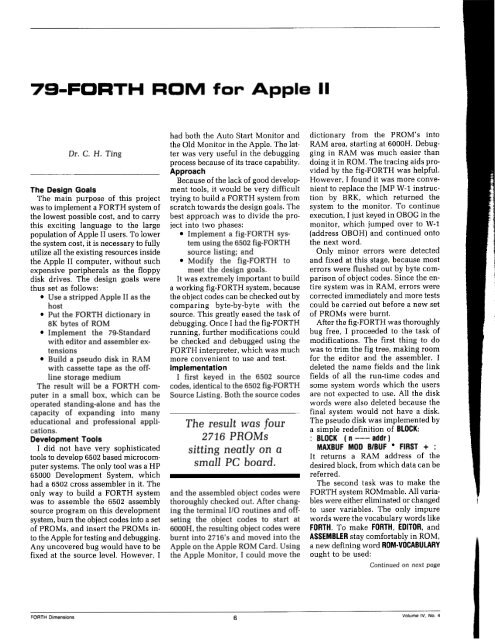V4N4 - Complang
V4N4 - Complang
V4N4 - Complang
You also want an ePaper? Increase the reach of your titles
YUMPU automatically turns print PDFs into web optimized ePapers that Google loves.
79lFORTH ROM for Apple II<br />
Dr. C. H. Ting<br />
The Design Goals<br />
The main purpose of this project<br />
was to implement a FORTH system of<br />
the lowest possible cost, and to carry<br />
this exciting language to the large<br />
population of Apple I1 users. To lower<br />
the system cost, it is necessary to fully<br />
utilize all the existing resources inside<br />
the Apple I1 computer, without such<br />
expensive peripherals as the floppy<br />
disk drives. The design goals were<br />
thus set as follows:<br />
Use a stripped Apple I1 as the<br />
host<br />
Put the FORTH dictionary in<br />
8K bytes of ROM<br />
Implement the %Standard<br />
with editor and assembler ex-<br />
tensions<br />
Build a pseudo disk in RAM<br />
with cassette tape as the off-<br />
line storage medium<br />
The result will be a FORTH com-<br />
puter in a small box, which can be<br />
operated standing-alone and has the<br />
capacity of expanding into many<br />
educational and professional appli-<br />
cations.<br />
Development Tools<br />
I did not have very sophisticated<br />
tools to develop 6502 based microcom-<br />
puter systems. The only tool was a HP<br />
65000 Development System, which<br />
had a 6502 cross assembler in it. The<br />
only way to build a FORTH system<br />
was to assemble the 6502 assembly<br />
source program on this development<br />
system, burn the object codes into a set<br />
of PROMs, and insert the PROMs in-<br />
to the Apple for testing and debugging.<br />
Any uncovered bug would have to be<br />
fixed at the source level. However, I<br />
had both the Auto Start Monitor and<br />
the Old Monitor in the Apple. The lat-<br />
ter was very useful in the debugging<br />
process because of its trace capability.<br />
Approach<br />
Because of the lack of good develop-<br />
ment tools, it would be very difficult<br />
trying to build a FORTH system from<br />
scratch towards the design goals. The<br />
best approach was to divide the pro-<br />
ject into two phases:<br />
Implement a fig-FORTH sys-<br />
tem using the 6502 fig-FORTH<br />
source listing; and<br />
Modify the fig-FORTH to<br />
meet the design goals.<br />
It was extremely important to build<br />
a working fig-FORTH system, because<br />
the object codes can be checked out by<br />
comparing byte-by-byte with the<br />
source. This greatly eased the task of<br />
debugging. Once I had the fig-FORTH<br />
running, further modifications could<br />
be checked and debugged using the<br />
FORTH interpreter, which was much<br />
more convenient to use and test.<br />
Implementation<br />
I first keyed in the 6502 source<br />
codes, identical to the 6502 fig-FORTH<br />
Source Listing. Both the source codes<br />
The result was four<br />
2726 PROMs<br />
sitting neatly on a<br />
small PC board.<br />
and the assembled object codes were<br />
thoroughly checked out. After chang-<br />
ing the terminal IIO routines and off-<br />
seting the object codes to start at<br />
6000H, the resulting object codes were<br />
burnt into 2716’s and moved into the<br />
Apple on the Apple ROM Card. Using<br />
the Apple Monitor, I could move the<br />
FORTH Dimensions 6<br />
dictionary from the PROM’s into<br />
RAM area, starting at 6000H. Debug-<br />
ging in RAM was much easier than<br />
doing it in ROM. The tracing aids pro-<br />
vided by the fig-FORTH was helpful.<br />
However, I found it was more conve-<br />
nient to replace the JMP W-1 instruc-<br />
tion by BRK, which returned the<br />
system to the monitor. To continue<br />
execution, I just keyed in OBOG in the<br />
monitor, which jumped over to W-1<br />
(address OBOH) and continued onto<br />
the next word.<br />
Only minor errors were detected<br />
and fixed at this stage, because most<br />
errors were flushed out by byte com-<br />
parison of object codes. Since the en-<br />
tire system was in RAM, errors were<br />
corrected immediately and more tests<br />
could be carried out before a new set<br />
of PROMs were burnt.<br />
After the fig-FORTH was thoroughly<br />
bug free, I proceeded to the task of<br />
modifications. The first thing to do<br />
was to trim the fig tree, making room<br />
for the editor and the assembler. I<br />
deleted the name fields and the link<br />
fields of all the run-time codes and<br />
some system words which the users<br />
are not expected to use. All the disk<br />
words were also deleted because the<br />
final system would not have a disk.<br />
The pseudo disk was implemented by<br />
a simple redefinition of BLOCK:<br />
: BLOCK ( n --- addr )<br />
MAXBUF MOD BlBUF FIRST + ;<br />
It returns a RAM address of the<br />
desired block, from which data can be<br />
referred.<br />
The second task was to make the<br />
FORTH system ROMmable. All varia-<br />
bles were either eliminated or changed<br />
to user variables. The only impure<br />
words were the vocabulary words like<br />
FORTH. To make FORTH, EDITOR, and<br />
ASSEMBLER stay comfortably in ROM,<br />
a new defining word ROM-VOCABULARY<br />
ought to be used:<br />
Continued on next page<br />
Volume IV, No. 4<br />
I

















